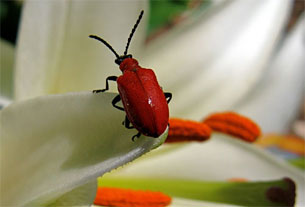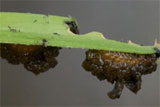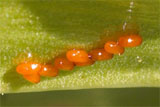Red lily beetle

The red lily beetle - also known as lilioceris lilii, scarlet lily beetle and lily leaf beetle -are hungry insects that can devour an entire lily plant and pose a very real threat to our gardens and green spaces.
Preventing and controlling the red lily beetle population
You can protect your yard and garden from the red lily beetle by taking the following steps:
- Inspect the soil around any lily bulbs or plants you purchase/receive, particularly if it is being shipped from outside Alberta. Overwintering adults and pupating larvae may be present in that soil.
- Hand-pick adults off plants in the early spring, and remove larvae throughout the summer to prevent an outbreak of red lily beetle in your garden and neighbourhood. Captured beetles may be dropped into a bucket of soapy water to prevent escape.
- Sprinkling diatomaceous earth – an organic, silica-based material – directly on these beetles will control them by creating abrasions that will cause them to dry out.
Recognizing the red lily beetle
Adults:
- Bright red beetle, 6-8 mm long, rectangular body shape.
- Body narrows at the shoulder.
- Black head, legs and underside.
- Not to be confused with red ladybird beetles (ladybugs) that have spots on their back.
Larvae:
- Yellow to orange soft bodies with black heads.
- Covered in slimy black fecal shield that allows them to appear as 'bird droppings'.
- Small larvae hide on the underside of leaves.
Why is the red lily beetle a problem?

Originally from Europe and Asia, the red lily beetle has been in Eastern Canada since 1943, but it only recently reached Calgary.
Red lily beetles have a voracious appetite and can completely destroy healthy lily plants. Native lily and Fritillaria species, as well as ornamental varieties, are susceptible to red lily beetle infestation, but daylilies are not attacked by this pest.

Red lily beetle adults are strong fliers and, once established, will readily spread to wherever their host plant exists. These beetles are believed to be well adapted to the wild lily populations in this region. Garden centres, nurseries, home and landscape gardeners should be vigilant and inspect planted lilies and any bulbs in soil that are received from other areas.

